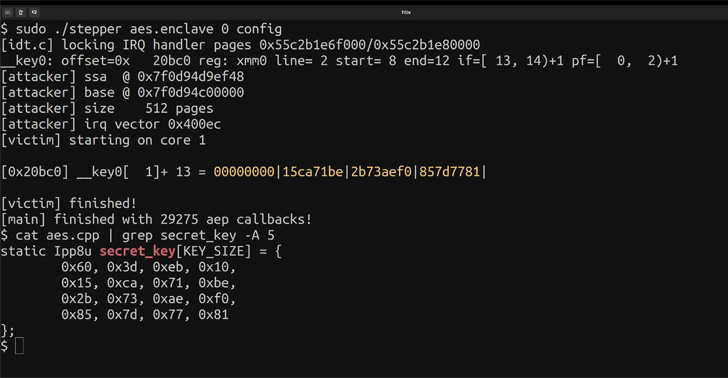A group of researchers has revealed details of a new
vulnerability affecting Intel CPUs that enables attackers to obtain
encryption keys and other secret information from the
processors.
Dubbed ÆPIC
Leak[1], the weakness is the
first-of-its-kind to architecturally disclose sensitive data in a
manner that’s akin to an “uninitialized memory read in the CPU
itself.”
“In contrast to transient execution attacks like Meltdown and Spectre[2], ÆPIC Leak[3] is an architectural bug:
the sensitive data gets directly disclosed without relying on any
(noisy) side channel,” the academics said.
The study was conducted by researchers from the Sapienza
University of Rome, the Graz University of Technology, Amazon Web
Services, and the CISPA Helmholtz Center for Information
Security.
The vulnerability (CVE-2022-21233[4], CVSS score: 6.0), which
affects CPUs with Sunny Cover microarchitecture, is rooted in a
component called Advanced Programmable Interrupt Controller
(APIC[5]), which provides a
mechanism to handle and route hardware interrupt
signals[6] in a scalable
manner.
“The scan of the I/O address space on Intel CPUs based on the
Sunny Cove microarchitecture revealed that the memory-mapped
registers of the local Advanced Programmable Interrupt Controller
(APIC) are not properly initialized,” the researchers noted.
“As a result, architecturally reading these registers returns
stale data from the microarchitecture. Any data transferred between
the L2 and the last-level cache can be read via these
registers.”
ÆPIC Leak specifically targets systems using Intel’s trusted
execution environment (TEE) known as Software Guard eXtensions
(SGX[7]), causing the leakage of
AES and RSA keys from secure enclaves that run on the same physical
CPU core with a success rate of 94% and 74% respectively.
“By protecting selected code and data from modification,
developers can partition their application into hardened enclaves
or trusted execution modules to help increase application
security,” Intel explains[8]
about the security assurances offered by SGX.
The flaw, put simply, breaks the aforementioned guarantees,
enabling an attacker with permissions to execute privileged native
code on a target machine to extract the private keys, and worse
defeat attestation, a cornerstone of the security primitives used
in SGX to ensure the integrity of code and data.
In response to the findings, Intel has released firmware
updates, while describing the issue as a medium-severity
vulnerability related to improper isolation of shared resources,
leading to information disclosure via local access.
It’s also worth noting that Intel has since deprecated[9]
support for SGX for its client CPUs, what with a litany of attack
methods plaguing the technology, including SGX-ROP[10], MicroScope[11], Plundervolt[12], Load Value
Injection[13], SGAxe[14], and VoltPillager[15].
SQUIP Side Channel Attack Affect AMD CPUs
The development comes as researchers demonstrated what’s the
first-ever side channel attack (CVE-2021-46778) on scheduler queues
impacting AMD Zen 1, Zen 2, and Zen 3 microarchitectures that could
be abused by an adversary to recover RSA keys.
The attack, codenamed SQUIP[16] (short for Scheduler
Queue Usage via Interference Probing), entails measuring the
contention level on scheduler queues to potentially glean sensitive
information.
No security updates have been released to patch the line of
attack, but the chipmaker has recommended[17] that “software
developers employ existing best practices, including constant-time
algorithms and avoiding secret-dependent control flows where
appropriate.”
References
- ^
ÆPIC Leak
(aepicleak.com) - ^
Meltdown
and Spectre (thehackernews.com) - ^
ÆPIC Leak
(github.com) - ^
CVE-2022-21233
(www.intel.com) - ^
APIC
(en.wikipedia.org) - ^
interrupt signals
(en.wikipedia.org) - ^
SGX
(thehackernews.com) - ^
explains
(www.intel.com) - ^
deprecated
(www.intel.com) - ^
SGX-ROP
(arxiv.org) - ^
MicroScope
(www.cs.cmu.edu) - ^
Plundervolt
(plundervolt.com) - ^
Load Value Injection
(lviattack.eu) - ^
SGAxe
(thehackernews.com) - ^
VoltPillager
(zt-chen.github.io) - ^
SQUIP
(stefangast.eu) - ^
recommended
(www.amd.com)
Read more https://thehackernews.com/2022/08/pic-and-squip-vulnerabilities-found-in.html

